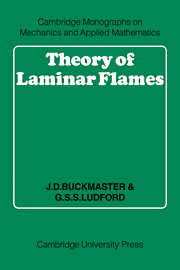Book contents
- Frontmatter
- Contents
- Preface
- 1 Governing equations of combustion
- 2 The premixed plane flame
- 3 Perturbations: SVFs and NEFs
- 4 Steady burning of a linear condensate
- 5 Unsteady burning of a linear condensate
- 6 Spherical diffusion flames
- 7 Cylindrical and spherical premixed flames
- 8 Multidimensional theory of premixed flames
- 9 Burners
- 10 Effects of shear and strain
- 11 Stability
- 12 Ignition and explosion
- Text references
- Further references
- Citation Index
- Subject Index
9 - Burners
Published online by Cambridge University Press: 05 May 2010
- Frontmatter
- Contents
- Preface
- 1 Governing equations of combustion
- 2 The premixed plane flame
- 3 Perturbations: SVFs and NEFs
- 4 Steady burning of a linear condensate
- 5 Unsteady burning of a linear condensate
- 6 Spherical diffusion flames
- 7 Cylindrical and spherical premixed flames
- 8 Multidimensional theory of premixed flames
- 9 Burners
- 10 Effects of shear and strain
- 11 Stability
- 12 Ignition and explosion
- Text references
- Further references
- Citation Index
- Subject Index
Summary
Features of a tube flame
Both inside and outside the laboratory it is commonly observed that a premixed flame can be stabilized at the mouth of a tube through which the mixture passes. Such a flame, usually conical in shape though not necessarily so, can be conveniently divided into three parts: the tip, the base (near the rim of the tube), and the bulk of the flame in between.
Elementary considerations of the flame speed and the nature of the flow explain the conical shape (see Figure 8.2 and the accompanying discussion). Simple hydrodynamic arguments provide salient features of the associated flow field, as we shall see in section 2; additional details are outlined in section 6.
An understanding of the nature of the combustion field in the vicinity of the rim is crucial in questions of existence and stability of the flame. Gas speeds near the tube wall are small because of viscous effects, so that if the flame could penetrate there it would be able to propagate against the flow, traveling down the tube in a phenomenon known as flashback. In actuality, the flame is quenched at some distance from the wall through heat loss by conduction to the tube (for a stationary flame); this prevents it from reaching the low-speed region. Such quenching enables unburnt gas to escape between the flame and the wall through the so-called dead space, a phenomenon that is described mathematically in section 5.
- Type
- Chapter
- Information
- Theory of Laminar Flames , pp. 154 - 174Publisher: Cambridge University PressPrint publication year: 1982



